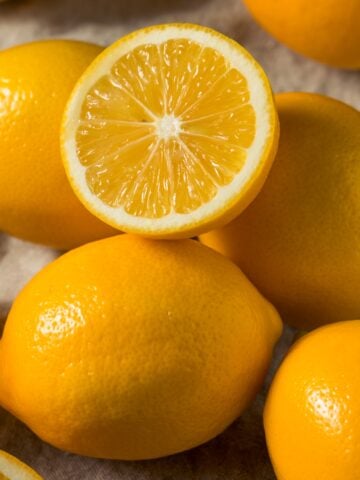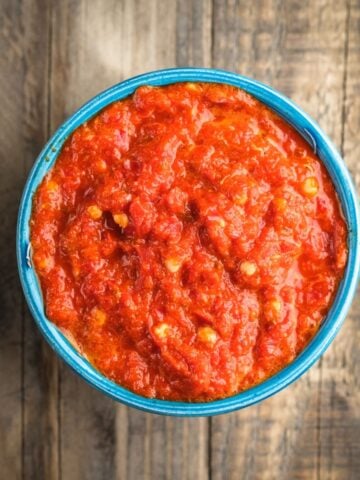Edam cheese has a mild, nutty, and buttery taste that is great on a grilled cheese or accompanying your favourite crackers on a cheeseboard. Considered one of the most popular cheeses in the world for its meltability, sometimes edam may not be so easy to find in your store.

When you can’t find edam, it’s good to have a backup plan. Here are some of the best substitutes for edam cheese.
WHAT IS EDAM CHEESE?
Edam cheese is a dutch cheese originating in the Netherlands. It is a semi hard cheese made of pasteurised cow’s milk and named for the town of Edam, located in North Holland.
Easily recognized by its red paraffin wax coating and golden interior, edam is a favorite of many cheese lovers.
Young edam cheese is soft and pliable and will have milder characteristics than aged edam.
WHAT IS THE DIFFERENCE BETWEEN CHEDDAR AND EDAM CHEESE?
Edam and cheddar cheese are similar in flavor and both are made from cow’s milk cheese. Edam cheese is well known for its origins in the Netherlands, while cheddar is a British cheese that was born in the village of Cheddar. Their similarities make cheddar cheese an ideal edam cheese substitute.
Edam is popular for its sweet and nutty flavour profile, as well as its smooth texture. Cheddar on the other hand, tends to be a little sharper and crumbles easily the older it gets, like many other aged cheeses. Edam has a lower fat content than cheddar.
Both cheeses are ideal for slicing or grating and add a great flavor to sandwiches, sauces, and pizza.
WHAT IS EDAM CHEESE USED FOR?
Edam is a versatile cheese with a mild nutty flavor, lower in fat than many other cheeses. Use edam anywhere you need a good melter such as grilled cheese sandwiches, pasta dishes, baked dishes, or even topping for baked potatoes.
Edam is sturdy enough to be sliced and eaten on a cold sandwich or wrap. It is also great for hamburgers or other hot sandwiches as it will melt and become gooey and delightful.

Would you like to save this?
HOW TO SERVE EDAM CHEESE
Edam’s pleasant flavour and texture make it an ideal cheese to put on a snack board along with fruits and crackers. At room temperature, edam will develop a little more flavor and aroma, as most cheeses do. Pair edam with peaches, apricots, and pears and sturdy cheese bearing crackers.
7 Edam Cheese Substitutes
Are you looking for an Edam Cheese Substitute? In this comprehensive list you'll learn 7 ideas for an alternative.
Swiss cheese simply refers to any cheese that is made in Switzerland. Because cheeses in this category commonly have a mild flavor and a medium texture to semi hard swiss cheese, they are excellent substitutes for edam cheese.
If you see a cheese referred to as swiss or alpine style, it is safe to assume that it will work as a substitute for edam for most recipes. Since swiss is also a good melting cheese, it can be used in recipes where a topping of cheese is called for.
Emmental cheese is a swiss, or alpine style cheese, from Switzerland. When you think of swiss cheese, you are likely envisioning emmental. Known for its savory flavor and mild nutty flavor, emmental makes a great stand-in for edam cheese.
Known for the small holes or “eyes” throughout, emmental cheese is a semi hard swiss cheese. Emmental is a cow’s milk cheese and is pale in color. Sliced in a sandwich or cubed on a charcuterie plate with meats, emmental is a fantastic stand in for edam. Emmental can also be found as a common ingredient in fondue.
Gruyere cheese is another cow’s milk alpine style cheese that can jump in as a substitute for edam cheese. With a nutty and fruity taste as a young cheese, gruyere has a prominent earthy taste the older it gets. It also has more of a salty sharp taste the more aged it is and becomes an aromatic cheese.
Gruyere cheese is often confused with emmental, but it does not have the same characteristic holes throughout, making it easy to spot the difference. It is also sharper than emmental, with a familiar nutty flavor that is common amongst alpine style cheeses.
Gruyere is often found in fondue alongside emmental. Also known as a topping for soups such as french onion, gruyere cheese is a great melting cheese that doesn’t overpower other ingredients. Most commonly you can find gruyere in the croque-monsieur, a delicious toasted french sandwich with ham that is topped with bechamel sauce.
Gouda cheese is a dutch cheese from the Netherlands that is commonly used as a substitute for edam. Gouda is one of the oldest recorded cheeses in the world that is still made today.
Gouda cheese is usually made from pasteurised cow’s milk and has a mild flavor and a firm but smooth texture, especially when it has been aged for a while. The longer gouda ages, the stronger the flavor becomes and the texture becomes crunchy due to cheese crystals that form throughout.
For an edam replacement, I recommend sticking with a younger gouda, as its characteristics will be the most similar to edam cheese. Gouda is a great ingredient in macaroni and cheese, and melts really nicely into cheesy mashed potatoes.
Cheddar cheese is another of the aged cheeses that can be used as a substitute for edam cheese. It is a popular cheese made of cow’s milk and originated in the English village of Cheddar in Somerset. Since edam tends to be on the mild side, using a mild cheddar cheese in a recipe that calls for edam is ideal.
Unlike more aged cheese, non aged cheddar cheese is easy to slice and not very crumbly. Cheddar is usually a hard cheese, and depending on the amount of time it has been aged it can become more crumbly.
Cheddar is usually white or yellow, depending on the use of the coloring annatto, which is a natural dye from a plant. When annatto is used to make cheddar yellow in color, it can give it a subtle nutty taste.
Cheddar is a great option for grilled cheese, as it melts well, just like edam. Try making cheddar puffs to put on the tables as an appetiser or accompaniment to dinner.
Fontina is a semi soft to hard cheese that originated in Italy. It is known for its nutty taste and mild flavor, making it an ideal replacement for edam. Like other mature cheeses, the longer it ages the harder the texture becomes and intense flavors turn.
Fontina cheese is an unpasteurized cow’s milk cheese, protected by a designation of origin, when produced in the Aosta Valley of Italy. This ensures that the cheese is made the same way with the same ingredients each time, lending to its mild flavor.
When young, fontina is often found in fondue, known as Fonduta alla valdostana in Italian. This recipe consists of fontina whipped with egg yolks, milk, and truffles, and is a popular take on the classic swiss fondue.
Try fontina with some spices and olive oil melted to make a dipping sauce for fresh bread. Fontina can be used in cheese toppings for potatoes, pizza, or pasta.
Appenzeller is a hard textured swiss or alpine style cheese that can be used as a substitute for edam. Appenzeller is a washed rind cheese, typically with wine or cider, resulting in a unique flavor and pleasant stink, but still resulting in the typical nutty taste known to be common amongst alpine style cheese.
Appenzeller cheese is sold in three different styles, related to their ageing. Classic is aged three to six months and is “mild spicy”. Surchoix, aged four to six months, has a “strongly spicy” flavor profile. Finally, Extra is aged six months and more and has a very strong “extra spicy” flavor profile and a tangy taste.
Appenzeller, like edam, is a good melting cheese and is sometimes used like raclette cheese to melt over potatoes. This cheese can also be used as a conversation starter on a cheese board, along with a nice glass of dry red wine.












Make my day! - Share your thoughts...